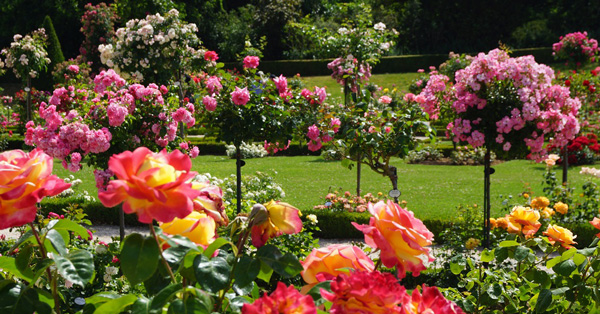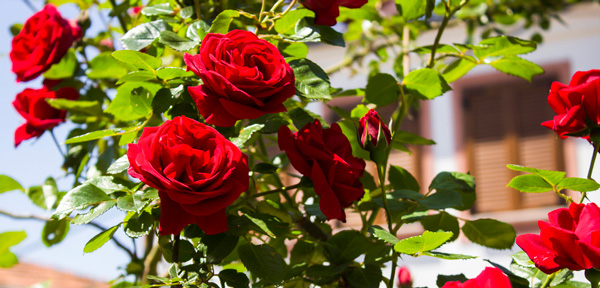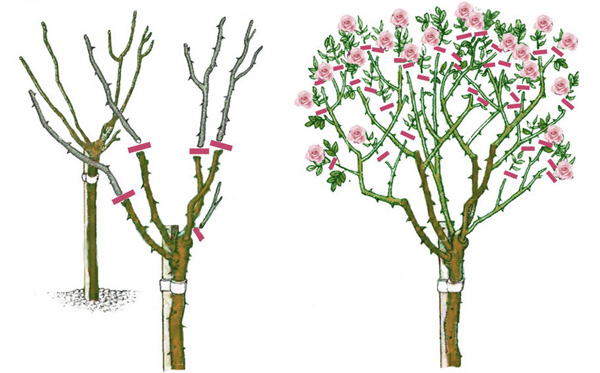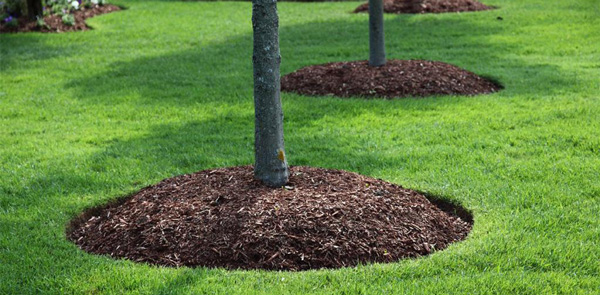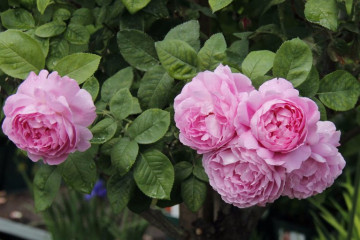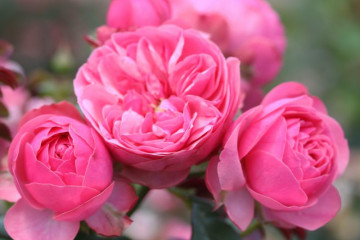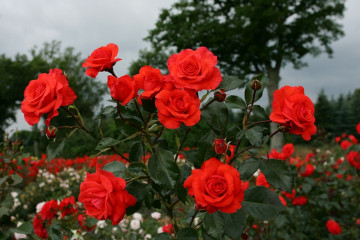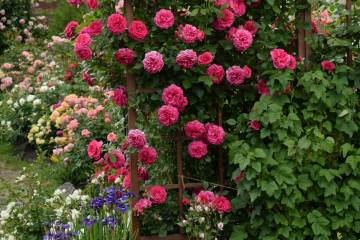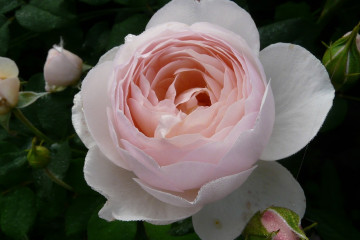Rose tree - features of growing a standard flower
Content:
- What is a standard rose, how to create it
- Description of a rose in the form of a tree, what is the height
- Most suitable varieties for tree formation
- Selection of standard rose seedlings
- How to plant a standard rose correctly
- Features of caring for a tree rose for tree formation
- Caring for a rose in winter, how to winter properly
- Growing problems, diseases and pests
Gardeners who have seen a standard rose at least once were eager to grow it. But few people know how to make a rose on a trunk. To cope with this difficult task, you should know the rules for the formation of such a flower.
What is a standard rose, how to create it
Externally, a standard rose is a flowering bush on a long trunk. It is easier to buy such a plant in a store, but you can create an unusual flower with your own hands.
For the stock, you need to grow a strong stem of a rose hip (wild rose). Within 2-3 years, a low bush is formed from the seedling, on which one powerful shoot is left. The bark on it should become woody.
Rose cuttings are grafted onto the grown stock in early May. Flowers of different shades can be grafted onto one stem. It is advisable to inoculate in 2 places, departing from the top of 20-30 cm. By the end of the year, the place of the scion should be tightened, and in the next season the tree will give its first flowers.
Low trees 50-100 cm high are formed from miniature roses that grow in the room. Hybrid tea species and floribundas are located at a height of 150 cm. Climbing varieties can grow on a trunk up to 2 meters.
Advantages and disadvantages of such a rose
Pluses of a flower on a trunk:
- The rose tree is formed from a wild rose stock, which is adapted for wintering in a cold climatic zone. This quality makes the flower resistant to freezing.
- The high position of the crown above the ground protects foliage and buds from dampness and damage by crawling insects.
- The tree plant has an aesthetic superiority over bush species. Highly located inflorescences attract the glances of passers-by from afar.
- The powerful stem of the plant provides the rose with sufficient nutrition, which guarantees abundant and long-lasting flowering.
Disadvantages of a tree rose:
- The high cost of planting material, which is formed based on the long growth period of the stock (up to 5 years).
- The difficulty of pruning the crown of the bush.
Description of a rose in the form of a tree, what is the height
A rose in the form of a tree looks like a flowering bush on a dais from a sturdy trunk. The height of the trunk can vary from 30 cm to 2 meters. The crown is in the form of a weeping bush, a direct, lush bouquet with large flowers, and small buds are grafted from home plant varieties.
Most suitable varieties for tree formation
All plant varieties can be grown on a trunk. Below are the names of roses that are spectacular like a tree. But they can also be grown as a bush.
Princess de Monaco
Hybrid tea variety. The bud has the shape of a glass, white with a pink dusting, up to 14 cm in diameter. The hybrid is distinguished by good resistance to disease and frost. Blooms throughout the summer, fallen flowers are replaced by many new ones.The variety has won a number of international rose growing awards. Suitable for decorating small gardens.
Jardins de Bagatelle
An upright shrub with single flowers on the stems. The buds have a half-open appearance, the color is beige-pink, the petals are twisted. The hybrid has a pronounced aroma during flowering. The species is winter-hardy, therefore, in the northern regions it can be grown in the open field.
Marcel Pagnol
The cone-shaped dark red flowers of the plant are ideal for cutting and have a heady aroma. Marcel Pagnol is one of the most popular varieties in the world. The height of the shoots can reach 1.5 m, and the size of the bud is 12 cm. The petals are velvety, with a slightly wavy edge. The bush is distinguished by abundant re-flowering, the flower is in the shape of a bowl.
Catherine Deneuve
The flower is valued for the rare color of the petals - orange-salmon. The bud opens up to 12 cm in diameter. On moist, fertilized soils, the rose blooms profusely. The bush is resistant to powdery mildew and pests.
Selection of standard rose seedlings
Planting material is purchased in garden stores or nurseries. It is important that the trunk is lignified. The stock should be formed from a rosehip cuttings. The bushy part of a good seedling does not have fresh scars and signs of disease at the grafting site with a base.
How to plant a standard rose correctly
Planting a tree rose and caring for it requires some knowledge. The place for the plant is chosen sunny, well-ventilated, but without strong drafts. In early May, you can plant a bush in open ground.
If other crops have already grown on the site, the land must be replaced. To do this, dig a hole 70 * 70 and fill it with a nutrient mixture. The tree must be placed in the hole without deepening; a peg for support must be tied to the trunk. After planting, the earth is watered abundantly with water at room temperature.
You can grow a rose tree in a winter garden. When kept at home, the container with the plant is taken to the basement for the winter and stored at a temperature of 1-3 ° C.
Features of caring for a tree rose for tree formation
All growers know the name of a rose that grows like a tree. But people face the peculiarities of growing only after buying a plant. Care consists in watering, feeding, loosening the soil, treating pests and diseases, as well as removing side shoots and old branches.
Watering rules and humidity
It is important to achieve a balance in the moisture content of the soil and air. Roses are afraid of dampness, and the place for their growth must be well ventilated. Plants do not need to be placed in lowlands. Fog often collects there, which contributes to the development of late blight.
The amount of watering will vary depending on the composition of the soil. Heavy soil does not allow water to pass through well, which leads to decay of the roots of the flower. The tree does not like drought; for abundant flowering, the bush should be watered often. In arid places, the rose garden is watered several times a week.
Top dressing and soil quality
Although the tree rose is grown on a wild rootstock, which is not afraid of poor soils, it does better in clay mixtures. Acidic soil is diluted with sand, depleted soil is fertilized with humus.
In the spring, mineral fertilizers are applied under the bush. Top dressing with a high potassium content stimulates the flowering of the tree.
Loosening and mulching
To ensure aeration of the root system, in the near-trunk circles, the earth is periodically loosened. Do this after each watering.
Young seedlings are mulched with bark, sawdust, coniferous litter. This protects the roots from drying out. For the winter, the base of the trunk is laid with mulch from horse manure.
Pruning
Wild growth is actively forming on the trunk, which must be removed. The extra branches take away the plant's nutrients.
As the roses grow, the crown is formed, getting rid of the growth that grows inside the bush. You do not need to cut the stems too short, 6 buds are left on the handle. Also, old branches that have died out during the winter are removed, and young shoots are shortened.
The operation is performed with a pruner or lopper, cutting off the branch half a centimeter above the bud. The floor is cut at an angle of 45 degrees, and the open wound is smeared with garden pitch.
Bush pruning is carried out after flowering, in late autumn. So, before winter, the plant will not have time to start new shoots. In the spring, pruning of the bush is done before the start of sap flow.
Caring for a rose in winter, how to winter properly
After pruning, before the start of frost, the standard rose is covered for the winter. Dense spandbond and burlap are used as a covering material. The protective layer should cover the entire crown of the plant and the grafting point. The trunk is covered with earth, the mound should cover the base well.
A young seedling can be bent to the ground. This is done carefully so as not to break the barrel. The branch is covered with spruce legs.
In the spring, as soon as a constant above-zero temperature has been established at night, the shelter is removed from the bush in order to avoid damping of the buds.
Growing problems, diseases and pests
Taking care of a woody rose is more difficult than its bushy species. The strong trunk is difficult to bend to the ground for shelter for the winter, and the bark can be damaged by rodents. When forming the crown of a tree, inexperienced gardeners often cut off excess branches, disrupting the flowering next year.
Roses love to attack whiteflies and aphids. In humid conditions, powdery mildew often appears, spotting on the leaves.
How to deal with them
Pests are destroyed with the help of insecticidal preparations, which are sold in large quantities in garden stores. Affected leaves and shoots are cut and burned.
Preventive treatment with fungicides is carried out at the beginning of summer, in the middle of flowering and before shelter for the winter.
Gardeners do not need to be afraid to plant standard roses on their plots. Proper agricultural techniques will help create a beautiful rose garden from different varieties. The addition of woody rose crops to the landscape design will improve its aesthetic qualities.
